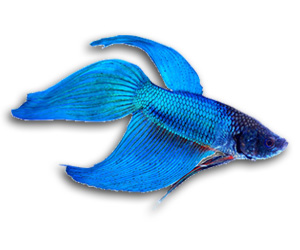Betta (Siamese Fighting Fish)

Quick Stats
| Size | Up to 3" (8cm) |
|---|---|
| Tank | Any. 25 litres or above is ideal |
| Swimming Area | All |
| Ph | 6 to 8 |
| Temperature | 73ºF to 86ºF (23-30°C) |
| Food | Flakes and Bloodworm |
Common Name:
Betta or Siamese Fighting Fish
Distribution:
India, particularly the Malay Peninsula, Singapore, Thailand and also Vietnam.
Colouration:
The long finned, highly colorful strains of the betta we know today vary greatly from the original wild forms. Today we have Flesh-colored, bright Blue Emerald Green, Red, Red-Violet and even Jet Black. These colors can be found alone or more commonly a mixture of two or more of them. The original form has much less variation. The colors are only intense when the fish is fighting or breeding and tend to be washed out at all other times. When this happens the Betta is a non spectacular Reddish-Brown with two transverse bars visible on the body. Females, even today are mostly Yellow-Brown, with short fins.
Lifespan:
2 to 3 years
Maintenance:
10% weekly water changes. They have no special requirements regarding water composition. The most important thing to remember is that male Bettas will not tolerate the presence of another male and will fight to the death to protect his territory. To this day some Species of Betta are placed together for the sole purpose of fighting, thus the other common name "Siamese Fighting Fish". Ensure that there is sufficient oxygen available at the surface as these fish breathe atmospheric air.
Feeding:
It has no specific feeding requirements and will accept all flake food as well as supplemental live.
Substrate:
Dark gravel. Type is not important.
Tank Decor:
Adding some floating plants such as Elodea Densa and a few hiding places will make this fish feel secure. Make sure the fish has unrestricted access to the surface to allow it to breath.
Filtration:
Filtration is not important as these fish are usually found in rice paddy's with no water flow whatsoever. Small weekly water changes will suffice.
Biotype:
Marshy areas, including rice fields also canals in Thailand.
Breeding:
Bettas are probably the best known members of the "bubble nest" builders. The nest consists of air bubbles enclosed in saliva and are very strong. The nest is always built by the male and is located at the water surface among floating plants. The eggs when laid sink to the bottom and are gently picked up by the male and spat into the nest. He will keep the nest in constant repair and will try to guard it from all intruders. The female should be removed after spawning as the male may kill her after the eggs are laid. The eggs hatch in one to two days and are very small. The fry can eat only the smallest of food. Growth is rapid. Care must be taken in the first few weeks to maintain temperature as the development of the Labyrinth is sensitive to change.